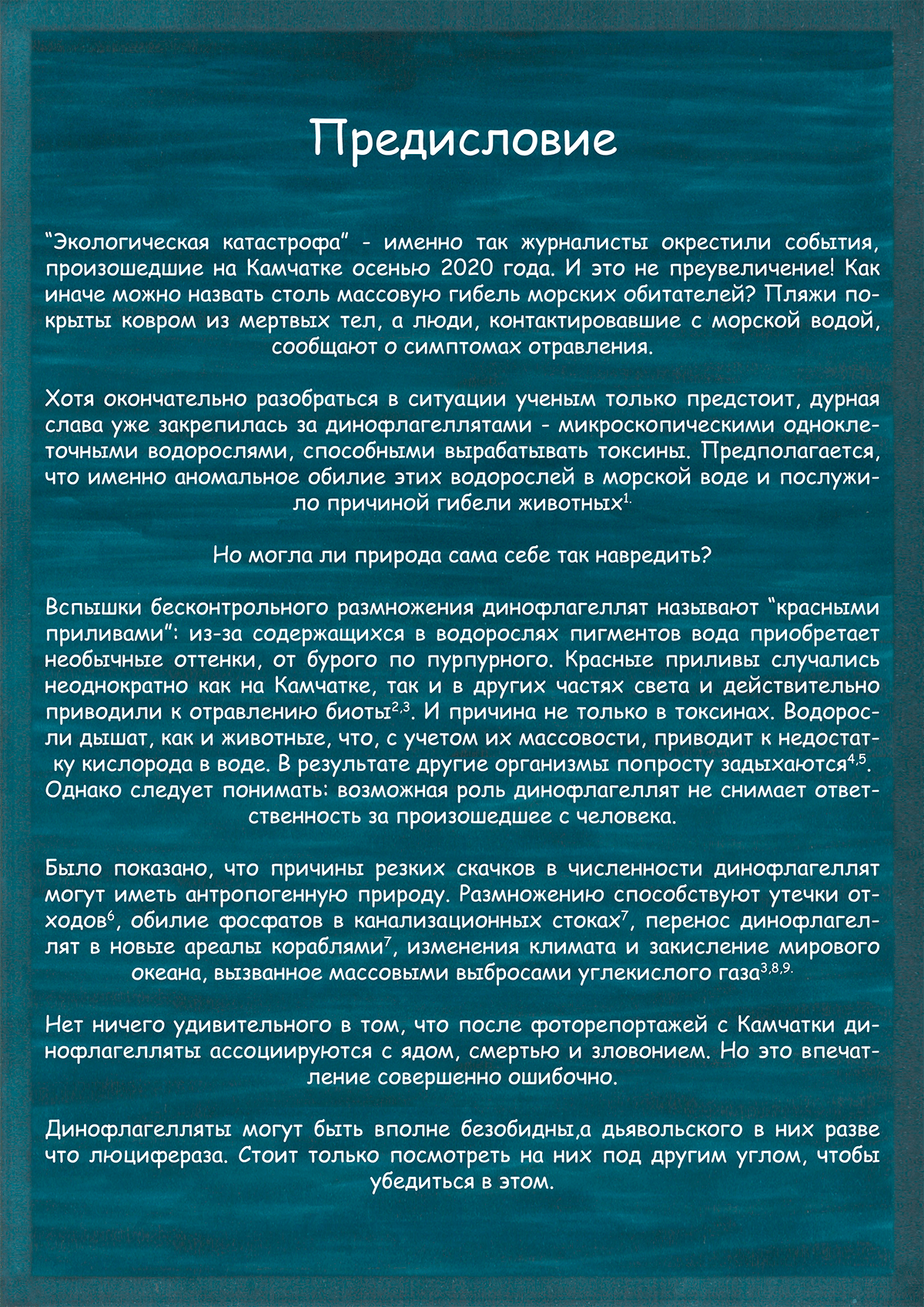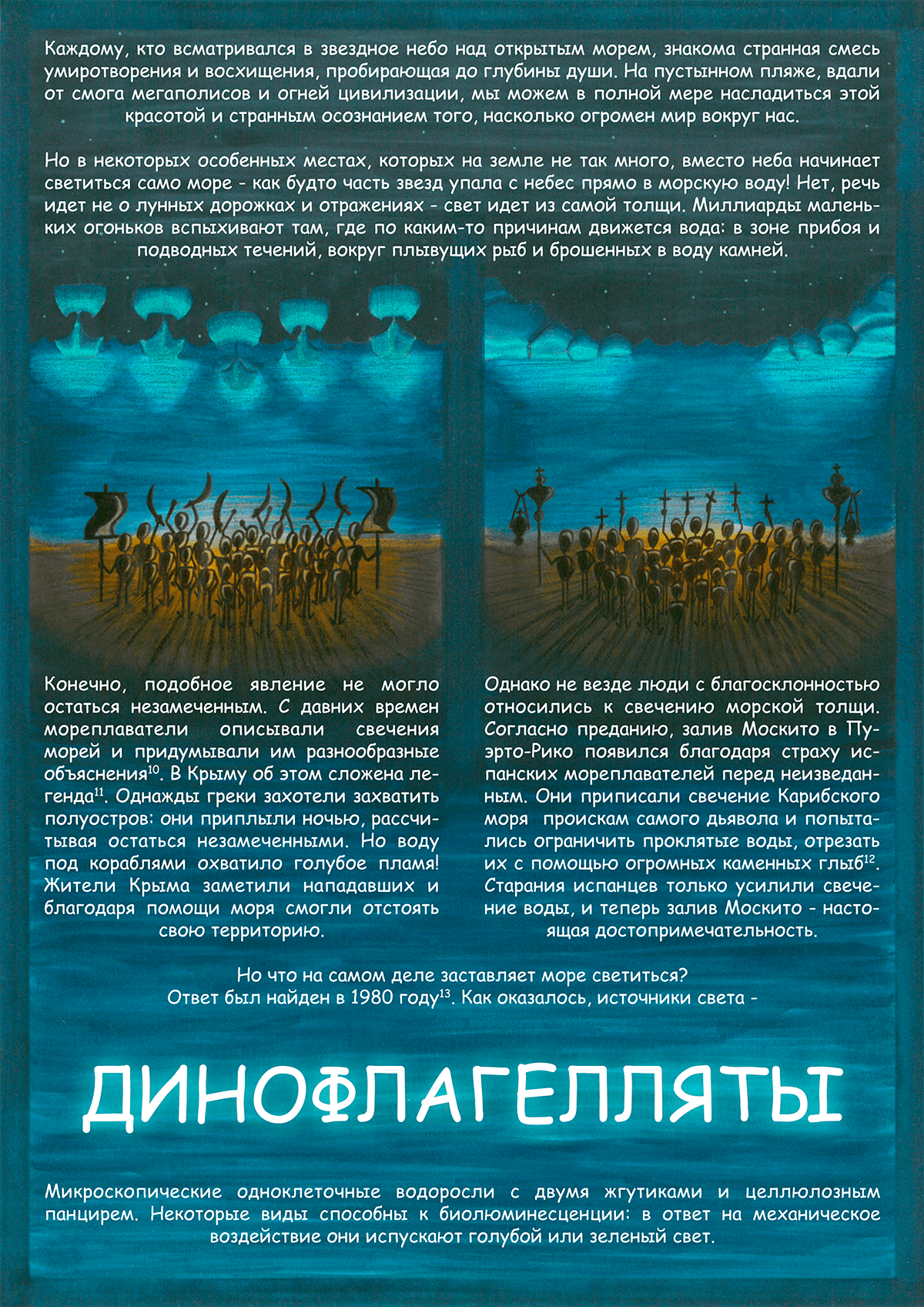
Плавая в звездах: альтернативный взгляд на убийц с Камчатки — динофлагеллят
26 января 2021
Плавая в звездах: альтернативный взгляд на убийц с Камчатки — динофлагеллят
- 562
- 0
- 3
Не так-то просто полакомиться динофлагеллятами: они светятся от малейших колебаний воды, так что скорее уж кто-то другой полакомится тобой. Очень изящный способ избавиться от врагов, правда? Рисунок в полном размере.
-
Автор
-
Редакторы
Комикс на конкурс «Био/Мол/Текст»: Из-за массовой гибели морских обитателей на Камчатке микроскопические водоросли динофлагелляты обрели репутацию морских Чикатило. Но на самом деле они вовсе не кровожадные убийцы! Эти крохотные существа с их затейливым строением и способностью светиться в темноте были объектами поклонения и героями легенд. Они вдохновляли писателей и ученых, и вдохновляют до сих пор. Просто это не так подробно освещается в прессе. Что же, пора это исправить!
Конкурс «Био/Мол/Текст»-2020/2021
 Эта работа заняла первое место в номинации «Наглядно о ненаглядном» конкурса «Био/Мол/Текст»-2020/2021.
Эта работа заняла первое место в номинации «Наглядно о ненаглядном» конкурса «Био/Мол/Текст»-2020/2021.

Генеральный партнер конкурса — ежегодная биотехнологическая конференция BiotechClub, организованная международной инновационной биотехнологической компанией BIOCAD.

Спонсор конкурса — компания SkyGen: передовой дистрибьютор продукции для life science на российском рынке.

Спонсор конкурса — компания «Диаэм»: крупнейший поставщик оборудования, реагентов и расходных материалов для биологических исследований и производств.

«Книжный» спонсор конкурса — «Альпина нон-фикшн»
Комикс доступен в формате pdf на русском и английском языках.






Литература
- Татьяна Клочкова: Цветения динофлагеллятов в Авачинском заливе уже бывали. (2020). «Камчатский край»;
- Коновалова Г.В. «Красные приливы» у Восточной Камчатки (атлас-справочник). Петропавловск-Камчатский: Камшат, 1995. — 56 с.;
- Nick Young, Richard A. Sharpe, Rosa Barciela, Gordon Nichols, Keith Davidson, et. al.. (2020). Marine harmful algal blooms and human health: A systematic scoping review. Harmful Algae. 98, 101901;
- J.H. Landsberg, L.J. Flewelling, J. Naar. (2009). Karenia brevis red tides, brevetoxins in the food web, and impacts on natural resources: Decadal advancements. Harmful Algae. 8, 598-607;
- Philip M. Gravinese, Mary Kate Munley, Grace Kahmann, Cody Cole, Vincent Lovko, et. al.. (2020). The effects of prolonged exposure to hypoxia and Florida red tide (Karenia brevis) on the survival and activity of stone crabs. Harmful Algae. 98, 101897;
- Отравление Камчатки: новые результаты. (2020). «Редакция»;
- E. Zohdi, M. Abbaspour. (2019). Harmful algal blooms (red tide): a review of causes, impacts and approaches to monitoring and prediction. Int. J. Environ. Sci. Technol.. 16, 1789-1806;
- Ученый связал гибель животных на Камчатке с изменением климата. (2020). РИА Новости;
- Vera L. Trainer, Stephanie K. Moore, Gustaaf Hallegraeff, Raphael M. Kudela, Alejandro Clement, et. al.. (2020). Pelagic harmful algal blooms and climate change: Lessons from nature’s experiments with extremes. Harmful Algae. 91, 101591;
- Тезинг К. (1914). Свечение моря // Чудеса природы. Пг., 1914. С. 71–74;
- Таран Г. Легенды Крыма. Симферополь: «Крымиздат», 1963. — 264 с.;
- Mambra S. (2019). Biobay: a sea that glows at night. Marine Insight;
- Beatrice M. Sweeney. (1980). Intracellular Source of Bioluminescence. International Review of Cytology. 173-195;
- Крахмальный К.Ф. Динофитовые водоросли Украины (иллюстрированный определитель). Киев: «Альтерпрес», 2011. — 444 с.;
- Brenda María Soler-Figueroa, Ernesto Otero. (2015). The Influence of Rain Regimes and Nutrient Loading on the Abundance of Two Dinoflagellate Species in a Tropical Bioluminescent Bay, Bahía Fosforescente, La Parguera, Puerto Rico. Estuaries and Coasts. 38, 84-92;
- Gires Usup, Asmat Ahmad, Kazumi Matsuoka, Po Teen Lim, Chui Pin Leaw. (2012). Biology, ecology and bloom dynamics of the toxic marine dinoflagellate Pyrodinium bahamense. Harmful Algae. 14, 301-312;
- Lee R.E. Phycology (4th Edition). Cambridge University Press, 2008. — 560 p.;
- Mallipattu S., Haidekker M., P. Von Dassow, Latz M., Frangos J.. (2002). Evidence for shear-induced increase in membrane fluidity in the dinoflagellate Lingulodinium polyedrum. Journal of Comparative Physiology A: Sensory, Neural, and Behavioral Physiology. 188, 409-416;
- J. B. Lindström, N. T. Pierce, M. I. Latz. (2017). Role of TRP Channels in Dinoflagellate Mechanotransduction. The Biological Bulletin. 233, 151-167;
- Roger Eckert, Takao Sibaoka. (1968). The Flash-Triggering Action Potential of the Luminescent Dinoflagellate Noctiluca. Journal of General Physiology. 52, 258-282;
- S. M. E. Smith, D. Morgan, B. Musset, V. V. Cherny, A. R. Place, et. al.. (2011). Voltage-gated proton channel in a dinoflagellate. Proceedings of the National Academy of Sciences. 108, 18162-18167;
- Rodriguez J.D. (2016). The HV1 proton channel of Lingulodinium polyedrum localizes to the bioluminescent scintillon. Master of Science in Integrative Biology Theses;
- Michel Desjardins, David Morse. (1993). The polypeptide components of scintillons, the bioluminescence organelles of the dinoflagellate Gonyaulax polyedra. Biochem. Cell Biol.. 71, 176-182;
- M. Kurfurst, S. Ghisla, J. W. Hastings. (1983). Bioluminescence emission from the reaction of luciferase-flavin mononucleotide radical with superoxide ion. Biochemistry. 22, 1521-1525;
- K. J. Fleisher, J. F. Case. (1995). Cephalopod Predation Facilitated by Dinoflagellate Luminescence. The Biological Bulletin. 189, 263-271;
- Omar Rifaie‐Graham, Nikolas F. B. Galensowske, Charlie Dean, Jonas Pollard, Sandor Balog, et. al.. (2021). Shear Stress‐Responsive Polymersome Nanoreactors Inspired by the Marine Bioluminescence of Dinoflagellates. Angew. Chem. Int. Ed.. 60, 904-909;
- Till Saxer, Andreas Zumbuehl, Bert Müller. (2013). The use of shear stress for targeted drug delivery. Cardiovascular Research. 99, 328-333;
- Ludwig Klermund, Kathrin Castiglione. (2018). Polymersomes as nanoreactors for preparative biocatalytic applications: current challenges and future perspectives. Bioprocess Biosyst Eng. 41, 1233-1246;
- Nathaniel J. Himmel, Daniel N. Cox. (2020). Transient receptor potential channels: current perspectives on evolution, structure, function and nomenclature. Proc. R. Soc. B.. 287, 20201309;
- Antony K. Chen, Michael I. Latz, John A. Frangos. (2003). The use of dinoflagellate bioluminescence to characterize cell stimulation in bioreactors. Biotechnol. Bioeng.. 83, 93-103;
- J. W. Hastings. (2007). TheGonyaulaxClock at 50: Translational Control of Circadian Expression. Cold Spring Harbor Symposia on Quantitative Biology. 72, 141-144;
- M. Dale Stokes. (2004). Bioluminescence imaging of wave-induced turbulence. J. Geophys. Res.. 109;
- S. D. Miller, S. H. D. Haddock, C. D. Elvidge, T. F. Lee. (2005). Detection of a bioluminescent milky sea from space. Proceedings of the National Academy of Sciences. 102, 14181-14184.






